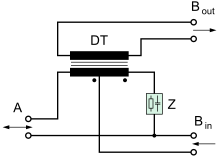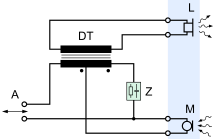Hybrid circuit
A hybrid circuit is used in the telecommunications used a four-wire line with a double wire to couple and vice versa and therefore an undisturbed in approximation signal transmission to allow in both directions over a two-wire line. It is a directional coupler for low frequency .
The hybrid circuit is a simple form of echo compensation in which the transmitted signal is "subtracted" from the received duplex signal with a differential transformer (DT) after appropriate filtering ( line simulation or echo signal estimation) .
It is located, for example, in analog telephones as a so-called back hearing loss circuit and enables simultaneous listening and speaking via just one pair of wires without the speaker hearing himself too loud in the telephone receiver .
Applications
Back loss
The figure on the right shows the hybrid circuit as it is used in analog telephones in the fixed network . The connection line coming from the left is simulated by the network marked Z on the right . This line simulation must be as similar as possible to the complex impedance of the connection line; it is simulated from resistors and capacitors . The values of the components used are adjusted depending on the cable length. The signal from the microphone M (low-resistance) is transmitted in equal parts both via the connecting line and via the line simulation on the primary side of the transformer DT with center tap . Due to the opposite direction of the microphone alternating current in the two primary windings, the signal from the microphone is ideally canceled in the secondary winding of the transformer and is not output via the loudspeaker L. The signal from the remote station, on the other hand, reaches the loudspeaker L (high-resistance) via the connection line via the primary windings of the transformer DT and line simulation, which are in series for this signal direction, and is output there. This means that the microphone's own sound signal is suppressed in the loudspeaker, while the sound signal of the remote station in the loudspeaker is only insignificantly attenuated by the hybrid circuit. In the case of telephone sets, however, the back loss should not be ideal (i.e. infinite), since the speaker then has the impression of a "dead" line . A certain amount of personal language in the telephone receiver is desired.
Analog transmission network
Hybrid circuits were also important assemblies in the analogue transmission system. Due to the attenuation of the signal, amplifiers have to be inserted into the lines at regular intervals . However, since amplifiers only work in one direction, the call directions must be separated by a hybrid circuit before amplification on a pair of wires; behind the amplifier they can be brought together again or passed on via a four-wire (long-distance) connection (see below).
The signal separation from two to four-wire lines is never completely successful, as the adaptation of the line simulation is not perfectly coordinated. A small portion of the signal always reaches the return channel and can then be heard by the sender (if the line is long enough, possibly as an echo ). For this reason, the number of “forks” on a trunk line is limited; In practice, the long-distance connections between the exchanges were therefore four-wire, even if more lines were required.
broadcast
When listeners call in and go “live” on a radio broadcast, they must turn off their radio receiver to avoid feedback ; they will then hear the broadcast over the phone. Particularly complex, finely tuned or digitally executed hybrid circuits (also known as telephone hybrids because of the mixture of two and four-wire systems) then result in a twin wire ("speaking") that is switched to the mixer for the broadcast, as well as another ("hearing “), Via which the transmitted audio signal is played to the caller. In this way, the caller's volume can also be regulated without influencing the played back signal.
NTBA
In the NT of the ISDN - the base connection is a hybrid circuit, the digital signals of the twisted about the U K0 interface to and from the switching center to the four-wire S 0 bus reacted within the house.
Here the line simulation is adaptive due to the higher requirements for the echo cancellation , i.e. i.e. it adapts automatically to the existing line.
properties
With hybrid switching, half of the own transmission power is lost in the line simulation, i.e. This means that twice the transmission power is required for the same range or, with the same transmission power, a correspondingly lower range compared to the four-wire line with a separate pair of wires for each direction.
literature
- Karl Steinbuch, Werner Rupprecht: communications engineering. An introductory presentation, 2nd edition, Springer Verlag, Berlin / Heidelberg 1973, ISBN 978-3-642-96135-9 .
- Harald Schumny: Signal transmission. 2nd revised edition, Friedrich Vieweg & Sohn Verlag, Braunschweig 1987, ISBN 978-3-528-14072-4 .
- Rolf Herheuser: Planning of switching networks . An introduction, vdf Hochschulverlag AG, Zurich 2008, ISBN 978-3-7281-3698-5 .
- Rudolf Nocker: Digital Communication Systems 2nd 1st edition, Friedrich Vieweg & Sohn Verlag, Wiesbaden 2005, ISBN 978-3-528-03977-6 .
- Hermann Weidenfeller: Basics of communication technology . Springer Fachmedien, Wiesbaden 2002, ISBN 3-519-06265-8 .
Web links
- Telephone Subscriber Line - An Example (accessed August 11, 2017)
- Active hybrid circuit attenuates the transmission signal (accessed on August 11, 2017)
- Investigation of active circulators for signal transmission in the audio frequency range (accessed on August 11, 2017)
- Analog user interface (accessed on August 11, 2017)


